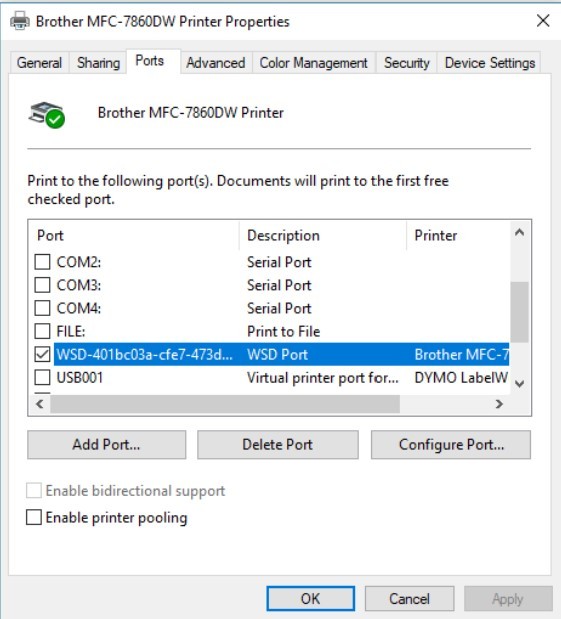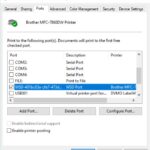

Well, that phrasing is just wrong. In fact TCP (Transmission Control Protocol) is replaced by WSD (Web Services For Devices) but IP is used in either case AND WSD is not a PORT it is a control mechanism. Sooo, it would be more accurate to ask WHAT IS THE DIFFERENCE BETWEEN TCP/IP PRINTER PORT MONITOR AND WSD/IP PRINTER PORT MONITOR?


Below is an excellent explanation from “LarryC” on an HP forum:
So how do these services make WSDMon different from TCPMon?
- Setup and Discovery – TCPMon is setup by a user (or software run by the user) that knows the IP address of the printer. If that address ever changes then it loses the printer. WSDMon can automatically install the printer when it is connected because it announces itself via WS-Discovery. It also checks the address of the printer with each print job so it is connected even if the address changes.
- Status Updates – TCPMon periodically (like every 10 minutes) polls the device status using SNMP to get updated status. WSDMon subscribes for printer events so that it gets updates immediately. It can tell you if there is a jam, no paper, out of ink/toner, etc. when it happens.
- Print Jobs – TCPMon prints via port 9100 and simply sends the data. There is very little, if any, feedback about whether the printer is ready to receive the data or who it is coming from. You don’t have information that you could use to cancel the job, etc. WSDMon sends a request to create a job and gets back an identifier to use to monitor and control the job. It then sends the data when the printer is ready for it.
Windows 8 enables WSDMon automatically. This means that you get a new printer on your computer when you connect it to the network – no other setup is necessary. That would not be very good in an enterprise situation because there may be hundreds of printers close enough to fill your printers folder. If there are more than 30 (a somewhat arbitrary number) printers then the process shuts itself off and you need to add the printer by IP address again. Whichever way it gets setup, you still get the rediscovery, eventing and print job control that TCPMon lacks.
.WSDMon will only work with printers that support the WSD services. This should be everything released in the last 5 years or so.
Of note, is that WDS is not limited to printers. Microsoft partner support provided this explanation to me:
WSD is a port monitor. A port monitor looks at the information coming in from the TCP/IP port and makes changes or routing depending on what comes into the port. Projected uses of WSD include:
• Printers and other shared network devices can be easily discovered, and when selected are automatically configured for the client computer.
• Automatic discovery of and connection to wireless devices, including cell phones, new overhead projectors, and home entertainment centers.
• Cameras that transfer pictures across the Internet to a user’s home computer, to their MSN Spaces site, or even to other devices.
• Home control systems that automatically discover and configure new lighting, heating, and other systems. These systems could be monitored and controlled from a computer located in the home or over the Internet.
Microsoft has a pretty good blog about it HERE if you want even more detail.
This website uses cookies.
View Comments
Thank all for an informative (and entertaining :) ) discussion of WSD "ports". I just learned a lot.
Over the past year or so, I instinctively switched problematic WSD port printers to a tcp/ip port/IP-address port during printing troubleshooting, and have found almost universally that the problems go away. There's a hilarious but extremely effective sales-training guy I knew years ago, who had an expression "DON'T HELP", that he passed on to his students who did not allow the sales process to go as it would, because they kept wanting to "help" the buyer out of facing uncomfortable truths about buying something. That's more than you need to know LOL, but it's an expression that needs to be regularly directed to MS: "Don't Help!", and "Don't think and make decisions for me!". Even my wife, bless her :), is regularly greatly irritated by MS software that across the board, tries to "think" and actually do things they assume you want to do. She is not a fan :). Neither am I, but MS and it's vagaries, have poured hundreds of thousands of dollars into my business :) over 20 years. Have a great and safe day everyone!
I'm trying to figure out (for my Brother 7065-DN laser printer with TCP/IP connectivity:
How did I get two entries in my printer list?
Brother 7065-DN
Brother 7065-DN (Copy 1)
And the odd part is: Everything just works.
But being curious: The top one is defined as using WSD Port and the other Standard TCP/IP Port.
Both offer to print from apps (you have a PRINT menu option when you highlight the definition.
In the view of available printers (including PDF printing stuff that acts as a printer), I see the two instances and the (Copy 1) version shows the green circle with the checkmark, the other does not.
But the thing prints and scans.
I don't want to break a working setup, but it seems odd to me to have TWO definitions of the same printer. Should I take one of these out and what could go wrong? Why do both work?
some times Windows will add the Printer as a WSD Printer with out you knowing and this is why you get 2 printer just make sure you only have it as IP Address Printer
It's not quite accurate to say IP port monitors are ignorant of printer status. It ignores things like PJL, built into virtually every printer (although it's a HP invention), particularly laser printers and MFPs. The printer status is almost always available via PJL on any standard connection. Still, the article is a good explanation of what WSD is and does, so kudos for that.
HP LaserJet Pro m404n
on a small Windows-10 Pro (64-bit) peer network with AT&T Uverse fiber-broadband..
WSD not working 100% on some machines, including those running new v1903 upgrade.
Set fixed-IP address on HP (like my other wired printers).
Login to it's IP from computer and Disable "Microsoft WSD Print" in Advanced Settings.
I left the other option: "Microsoft WS-Discovery" Enabled.
Reboot everything.
Printer should now detect, load driver, and work 100% reliable ... (as a more-conventional fixed-IP printer).
I'm tempted to turn off even more (ie, Apple and/or Web print).
Isn't leaner still better?
I had an issue whit Brother MFC 9570 CDW printer in our network. WSD was making to take 15-20 minutes to print any document because W7 set by itself the printer port to WSD instead to TCP/IP.
TCP/IP is you telling your printer what to do. WSD is microsoft screwing things up when you didn't ask them to.
That is an Elegant reply, concise, and entirely accurate!
That's the best comment about this issue.
Also the time everybody has to spent trying to figure out what is the problem due it, as happen to me, several days and hours blaming the routers, network cables, firewalls, viruses, installing and removing drivers, trying with other printers on the same ports and so.
Great article, I was having problems communicating with a new printer I added to my network. The printer was installed as a network printer (i.e. not a shared printer). I could print to the printer, but the printed document would not be removed from the printer queue and the printer would hang until I manually deleted the document from the printer queue. It turns out, that when I added the new printer to my computer, the printer got configured with a WSD Printer Monitor port. (I did select "autodiscovery" when I added the new printer driver) When I change the printer configuration to use a TCP/IP Printer port, everything started working fine. That's what lead me to ask the question what is a WSD Printer? and why would I want one? This article did a great job of explaining that.
Although, automatic discovery of network printer seems useful, it seems that WSD (at least in the printer world of devices) adds some complexity that isn't so plug and play as it is intended to be.
"it would be more accurate to ask WHAT IS THE DIFFERENCE BETWEEN TCP/IP PRINTER PORT MONITOR AND WSD/IP PRINTER PORT MONITOR"
Considering the fact that it's under Ports, and I can highlight it and click Delete Port, or Configure Port, I can't say I 100% believe you.
Thanks for such an understandable explanation!
very good explanation